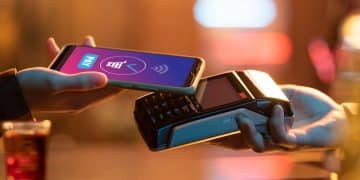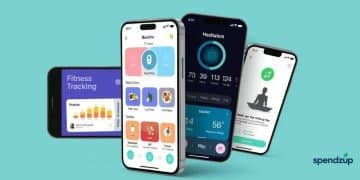Mobile check deposits: The modern way to bank without a branch

In today’s fast-paced digital world, mobile check deposits have revolutionized how consumers manage their finances, providing a convenient, secure, and efficient way to deposit checks using nothing but a smartphone.
As more financial institutions invest in digital transformation, mobile check deposits have become not just a feature but a standard expectation among banking customers in the United States.
With just a few taps and a camera snap, users can avoid the time-consuming process of visiting a bank branch or ATM, embracing a modern alternative that aligns perfectly with the mobile-first lifestyle many Americans lead today.
Understanding mobile check deposits and how they work
Mobile check deposit technology enables individuals to deposit checks into their bank accounts through their mobile banking app.
To initiate a mobile check deposit, the user simply logs into their bank’s mobile application, selects the deposit option, takes photos of the front and back of the check — ensuring all corners and endorsements are clear — and submits the deposit for processing.
This process can be completed in minutes from virtually anywhere, which is why mobile check deposits have become increasingly popular across all age groups, especially among digital natives.
Financial institutions typically impose limits on the amount and number of mobile deposits allowed daily or monthly.
Furthermore, checks deposited through mobile channels are subject to verification, and availability of funds may be delayed depending on bank policies, check amount, and user history.
Still, the convenience of skipping the physical bank location has made mobile check deposits a game changer.
Most banks require a specific endorsement such as “For Mobile Deposit Only” under your signature, and omitting this can result in rejection of the deposit.
Some institutions even require the use of a checkbox on the back of the check, indicating it is being deposited via mobile.
Security and privacy: are mobile check deposits safe?
One of the most frequently asked questions regarding mobile check deposits is whether they are safe. The short answer is yes. Banks and credit unions use encrypted technology and secure servers to transmit the images and data.
Multifactor authentication, biometric login options, and automatic logouts are additional layers of protection that safeguard user accounts.
Despite their digital nature, mobile check deposits are often more secure than traditional in-person deposits.
Unlike depositing a paper check at a branch — where it can be physically lost, stolen, or misplaced — the digital image is stored securely within the bank’s servers, minimizing the risk of theft or fraud.
To further protect yourself, it’s essential to retain the physical check for a short period after deposit — typically about two weeks — in case any verification issues arise.
Once the deposit has cleared, the check should be shredded to prevent any future misuse.
The rise of mobile banking and consumer adoption
Mobile banking has exploded in popularity over the last decade, and mobile check deposits are a core feature driving this digital banking revolution.
In 2023, an estimated 80% of U.S. adults used mobile banking services, with more than half having used mobile deposit features, according to Federal Reserve data.
The COVID-19 pandemic further accelerated this shift, as consumers sought contactless and remote banking options.
Banks responded by enhancing mobile app functionalities, educating consumers, and even offering incentives for using mobile features like check deposits.
The outcome? A more streamlined, user-centric banking experience that emphasizes speed, security, and flexibility. In addition to retail banking customers, small business owners and freelancers have found mobile check deposits especially beneficial.
Instead of interrupting their workday with a trip to the bank, they can quickly deposit client payments using their phones and continue with business operations uninterrupted.
Processing times and funds availability
When using mobile check deposits, understanding when your funds will be available is essential.
Generally, banks follow a similar protocol to in-branch deposits, with many offering same-day or next-day availability for deposits made before a specific cutoff time, usually around 5 p.m. local time.
However, larger checks or first-time deposits may trigger longer hold periods. It’s important to review your bank’s funds availability policy, which is typically disclosed in the mobile banking app or on the institution’s website.
Delays can also occur if the check is drawn on a foreign bank or flagged for potential fraud.
Comparing banks: Mobile check deposit limits and features
Not all banks offer the same mobile deposit features or limits. For example, some major banks like Chase, Bank of America, and Wells Fargo offer mobile deposit limits that vary depending on the user’s account history, type of account, and customer relationship.
Here’s a brief comparison of a few major banks:
| Bank Name | Daily Deposit Limit | Funds Availability | Special Requirements |
| Chase | Up to $2,000/day | Same or next business day | May vary by account |
| Bank of America | Up to $10,000/day | Same day if before cutoff | Requires endorsement |
| Wells Fargo | Varies (up to $5,000) | Next business day | App notification on hold duration |
| Capital One | Based on account | Usually next day | May require photo retake if unclear |
These figures can change based on account activity, the age of the account, or special promotions. Always consult your specific bank’s FAQ section or customer service for the most accurate details.
Common mistakes to avoid with mobile check deposits
While mobile check deposits are straightforward, several user errors can lead to failed deposits or delays. One of the most common mistakes is submitting blurry or cropped images.
The check must be fully visible in the photograph, with all four corners and important text clear and legible. Lighting matters too; using natural light or a well-lit room ensures better image quality.
Incorrect endorsements are another frequent issue. Forgetting to sign the check or to include “For Mobile Deposit Only” can lead to rejections.
Additionally, depositing the same check more than once, intentionally or accidentally, is a serious offense that could result in penalties or account suspension.
Always double-check the entered deposit amount to match the check. Errors here can trigger unnecessary delays, as the system flags discrepancies for manual review.
The future of mobile check deposits
As financial technology evolves, mobile check deposits are poised to become even more efficient and intuitive. Banks are investing in AI and machine learning to improve check image recognition, reduce fraud risk, and offer real-time approvals.
Biometric verification, such as fingerprint or facial recognition, will likely become more integrated to streamline authentication.
In the future, users might see immediate funds availability for certain verified deposits or receive real-time notifications when a check is flagged for issues.
Integration with other financial tools and digital wallets will also become more seamless, further consolidating the banking experience into a single app ecosystem.
With innovations on the horizon, consumers can expect a future where depositing checks via mobile will be nearly instantaneous and more secure than ever.
Why mobile check deposits are a must-have tool for modern banking
In a world where time is money, mobile check deposits offer an unparalleled advantage in convenience, speed, and flexibility.
They eliminate the need for branch visits, reduce paper handling, and provide a secure digital alternative that fits perfectly into a mobile-first lifestyle.
Whether you’re a student receiving a scholarship check, a freelancer being paid for a gig, or a retiree cashing a refund, mobile deposits cater to diverse financial needs.
As banks continue to refine and expand this feature, users will find even more reasons to rely on it. The ability to deposit checks from anywhere at any time transforms how people interact with their money, making mobile check deposits a cornerstone of digital banking.
If you haven’t yet embraced this feature, now is the perfect time to explore it through your bank’s mobile app and take advantage of everything it has to offer.
We hope this content has been helpful. Enjoy and stay tuned to our website for more!





